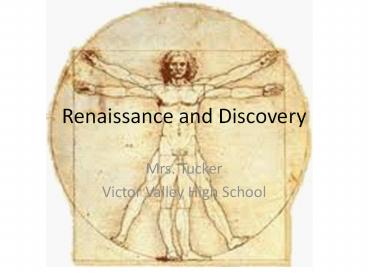Renaissance and Discovery - PowerPoint PPT Presentation
1 / 8
Title:
Renaissance and Discovery
Description:
Gutenberg's invention of the moveable-type printing press facilitated the wide ... Mexico lost approximately 92% of its population within a generation after the ... – PowerPoint PPT presentation
Number of Views:90
Avg rating:3.0/5.0
Title: Renaissance and Discovery
1
Renaissance and Discovery
- Mrs. Tucker
- Victor Valley High School
2
Renaissance 1375 - 1527
- a transition between the medieval and modern
worlds - a time of unprecedented cultural creativity.
- Italian city-states, with their extensive trade
networks and their competition with one another,
were great incubators for artistic expression,
political innovation, and humanistic studies. - the important elements of humanism included
studies of Classical languages and arts, and
moral preparation of the individual for a life of
virtuous action. - Authors and artists such as Petrarch, Dante,
Boccaccio, Leonardo da Vinci, Raphael, and
Michelangelo, exemplify the values of Renaissance
humanism.
3
Italys Political Decline
- In the late 15th century, the balance of power
between Italian city-states that had been
enforced through the Treaty of Lodi started to
unravel. - In 1495, at the invitation of the Milanese leader
Ludovico il Moro, French king Charles VIII
invaded Italy and conquered Florence. - This invasion triggered several rounds of
diplomacy, alliance-making, and strategic
marriages between popes, leaders of Italian
city-states, French kings, and the rulers of
Aragon and Brittany, among others. - After a quarter-century and various military
conflicts, the end result was political
fragmentation and military weakness in Italy. - In 1513, Niccolo Machiavelli wrote The Prince, in
which he argued that only a strong and cunning
dictator could unify Italy.
4
Revivial
- Sovereign monarchies, in which kings and their
appointed agents usually townspeople, not
nobility control national policies on taxation,
warfare, and law enforcement, emerged in France,
Spain, and England in the late 15th century. - In France, Charles VII and, later, Louis XI were
able to capitalize on the French victories over
England and Burgundy, to expand French territory,
build trade and industry, and suspend the Estates
General. - In Spain, Isabella of Castile and Ferdinand of
Aragon married in 1469, and they proceeded to
impose state control on religion, arrange
marriages for their children that would shape
future European history, and sponsor global
exploration. - In England, Henry VII founded the Tudor dynasty
and instituted the Court of Star Chamber, which
allowed him to govern independently of
Parliament. - In Northern Europe, the Holy Roman Empire
(Germany) was the main example of a country that
did not develop a strong centralized monarchy in
this period.
5
Northern Renaissance
- The Renaissance spread from Italy to Northern
Europe through traders and merchants, students,
religious practitioners, and others. - Humanism in the North, however, was more
interested in religious reforms and in spreading
its message to a broad audience than Italian
humanism had been. - Gutenberg's invention of the moveable-type
printing press facilitated the wide dissemination
of texts. - Erasmus exemplified Northern humanists' interest
in reform of the Catholic Church. - In Germany, England, and France, humanism laid
the groundwork for the Reformation, but in Spain,
humanism, like most other aspects of culture, was
controlled by Ferdinand and Isabella, and
therefore did not challenge the Church.
6
Voyages
- In the 15th century, Europeans began to expand
which eventually led to European control over
huge regions of the globe. - Searching for gold, spices, and later, slaves,
the Portuguese, Spanish, and others established
maritime trade routes to the coasts of Africa,
India, and the Americas. - Spain established an empire in what became Latin
America, introducing Catholicism, new forms of
social, political, and economic organization
including labor servitude and diseases to which
the indigenous peoples had no resistance. - Mexico lost approximately 92 of its population
within a generation after the Spanish conquest. - Spain's empire brought new ideas to Europe, and
led to inflation.
7
Summary
- Recognizable modern nations with centralized
governments began to form in western Europe
during this period. - Europe's classical heritage was (re-)
"discovered" by intellectuals and artists, first
and most dramatically in the Italian Renaissance,
and later in northern Europe. - New lands, peoples, and products were also
"discovered" by Europeans, particularly the
Spanish and Portuguese the resulting exchanges
of ideas, goods, and living things (humans,
plants, germs) forever altered lives around the
world.
8
Essay Question Due Tuesday, 9/20
- Analyze the influence of humanism on the visual
arts in the Italian Renaissance. Use at least
THREE specific works to support your analysis.
- Write an essay that
- Has a relevant thesis.
- Addresses all parts of the question.
- Supports thesis with specific evidence.
- Is well organized.































